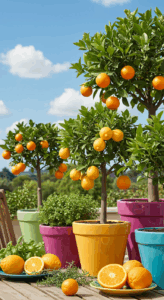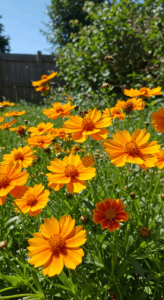1. Nature’s Salad: Dandelion Delight

Dandelions, often seen as mere weeds, are one of nature’s most versatile and nutritious wild plants. Both the leaves and flowers are edible, making them a perfect addition to salads, smoothies, or teas. The young leaves, harvested before the flowers bloom, are slightly bitter and can be enjoyed raw or sautéed. Rich in vitamins A, C, and K, as well as calcium and iron, dandelions are not only healthy but also packed with antioxidants. For a refreshing treat, consider using the bright yellow flowers to make dandelion wine or as a colorful garnish in dishes. Always ensure you gather dandelions from pesticide-free areas to enjoy their full benefits safely.
2. The Versatile Purslane: A Superfood in Disguise

Purslane, often overlooked in gardens and yards, is a nutritional powerhouse packed with omega-3 fatty acids, vitamins A, C, and K, and essential minerals. This succulent plant thrives in various environments, from sandy soils to rocky terrains, making it a resilient wild edible. The leaves and stems are tender and have a slightly tangy flavor, making them an excellent addition to salads, smoothies, or as a garnish. Not only is purslane versatile in culinary uses, but it also boasts impressive health benefits, including anti-inflammatory properties and high antioxidant content. Foraging for purslane is a sustainable practice, as it grows abundantly in the wild, allowing nature enthusiasts to enjoy this superfood without harming the ecosystem.
3. Clover Craze: Sweet Treats from the Ground

Clover, often found in meadows and grassy areas, is not just a common lawn plant; it’s a delightful wild edible packed with nutrients. Both the leaves and flowers are completely edible, offering a mildly sweet flavor that enhances salads and teas. Rich in vitamins A, C, and K, as well as minerals like calcium and magnesium, clover can be a beneficial addition to your foraging repertoire. When foraging for clover, look for vibrant green leaves with three leaflets, often adorned with a distinctive white or red marking. Be sure to harvest from areas free of pesticides and pollutants to ensure safety. You can enjoy clover raw, or dry the flowers to create a soothing herbal tea, making it a versatile treat that connects the wild with your culinary adventures.
4. Nettle Nirvana: A Sting That Packs a Punch

Nettle Nirvana, often overlooked in the wild, is a powerhouse of nutrition and flavor. These vibrant green plants, characterized by their serrated leaves and stinging hairs, can be found in damp, shaded areas. Despite their prickly reputation, nettles are edible and highly nutritious, rich in vitamins A, C, K, and several B vitamins, as well as minerals like iron and calcium. To safely harvest them, wear gloves to avoid the sting, and opt for young leaves, which are more tender and flavorful. Cooking or drying nettles neutralizes their sting, making them perfect for soups, teas, and pesto. Embrace the wild culinary adventure and experience the health benefits of these wild greens without fear of their initial bite.
5. Wild Garlic: The Secret Flavor Booster

Wild garlic, or Allium vineale, is a delightful edible plant that thrives in damp woodlands and shaded areas, often identifiable by its broad, vibrant green leaves and distinctive garlic aroma. This perennial plant typically blooms in spring, producing clusters of small, star-shaped white flowers that add a touch of beauty to any foraging excursion. Its leaves and flowers are not only edible, but they also serve as a fantastic flavor enhancer for a variety of dishes, from salads to soups and pestos. When foraging for wild garlic, be sure to distinguish it from toxic plants like lily of the valley, as its strong garlic scent is a telltale sign of its safe edibility. Use wild garlic fresh for a punch of flavor or dry it for later use, making it an excellent secret ingredient to elevate your cooking in the wilderness.
6. Acorns: Nature’s Nutty Powerhouse

Acorns, the seeds of oak trees, are often overlooked as a food source, yet they are a nutrient-dense powerhouse packed with healthy fats, carbohydrates, and proteins. Before consuming, it’s crucial to properly prepare acorns to remove their naturally occurring tannins, which can impart a bitter taste. The preparation process typically involves soaking and leaching the acorns in water for several days, changing the water frequently. Once processed, acorns can be ground into a flour for baking, added to granola, or even used to make a nutritious porridge. Rich in vitamins and minerals, acorns can be a great addition to your wilderness diet, providing energy and sustenance during outdoor adventures. Just remember to identify the right oak species, as some acorns are more palatable than others.
7. Lamb’s Quarters: The Forgotten Green

Lamb’s Quarters, often overlooked, is a nutrient-rich wild green that grows abundantly across North America. Known scientifically as Chenopodium album, this plant is easily identifiable by its broad, arrow-shaped leaves, which have a fine white powder on their undersides. Lamb’s Quarters is not only edible but also highly nutritious, packed with vitamins A, C, and K, as well as minerals like calcium and iron. You can consume it raw in salads, cook it like spinach, or even incorporate it into soups and stews. Harvest the younger leaves in the spring for the best flavor and tenderness. This resilient plant often thrives in disturbed soils, making it a reliable find for foragers seeking wild edibles in the wilderness.
8. Chickweed: The Tiny Green Gem

Chickweed, often overlooked due to its small size, is a nutritious edible wild plant that thrives in temperate regions. With its delicate, star-shaped white flowers and tender green leaves, chickweed is not only a culinary delight but also a powerhouse of vitamins A, C, and several B vitamins. It can be consumed raw in salads, added to sandwiches, or cooked like spinach for a nutrient-rich side dish. Foraging for chickweed is easy, as it grows abundantly in gardens, fields, and along roadsides, typically in cool seasons. When harvesting, be sure to collect it from unpolluted areas to avoid contaminants. Its mild flavor and soft texture make it a versatile ingredient that enhances any dish, providing both taste and health benefits.
9. Plantain: The Healing Herb Underfoot

Plantain, often dismissed as a common weed, is a powerhouse of healing properties and nutritional benefits. Found in a variety of habitats, this versatile herb boasts broad, flat leaves and a rosette shape, making it easy to identify. Its leaves can be used topically to soothe cuts, insect bites, and rashes due to their anti-inflammatory and antimicrobial properties. Rich in vitamins A, C, and K, as well as minerals like potassium and calcium, plantain is also edible; young leaves can be eaten raw in salads or cooked like spinach. When foraging, look for plantains in disturbed areas, roadsides, and gardens, ensuring they are free from pesticides. With its myriad uses, plantain is a true ally in the wilderness and an invaluable addition to your edible wild plant repertoire.
10. Burdock Root: A Root with Rich History

Burdock root, scientifically known as Arctium lappa, has been utilized for centuries in various cultures, particularly in traditional Chinese and Japanese medicine. This biennial plant produces a long, edible taproot that can grow up to two feet deep, boasting a slightly sweet and earthy flavor when cooked. Rich in antioxidants, vitamins, and minerals, burdock root is celebrated for its potential health benefits, including detoxification and anti-inflammatory properties. In the wilderness, it can be foraged during the spring and fall, and can be prepared in numerous ways, such as stir-fried, boiled, or pickled. Its versatility makes it not only a nutritious addition to meals but also a staple in survival foraging, offering sustenance and medicinal qualities when needed most.
11. Wild Raspberry: Nature’s Juicy Treat

Wild raspberries (Rubus idaeus) are a delightful, juicy treat found in many temperate regions, thriving in sunny, disturbed areas like forests edges and clearings. These small, red to black berries grow in clusters on thorny canes, typically ripening from late spring to early summer. When foraging for wild raspberries, look for plump, slightly soft berries that easily detach from the stem; avoid those that appear overly firm or shriveled. Besides being deliciously sweet, wild raspberries are packed with vitamins C and K, fiber, and antioxidants, making them a nutritious snack. They can be enjoyed fresh, added to salads, or used to make jams and desserts, providing a versatile option for any wilderness meal. Always ensure proper identification and ethical foraging practices to preserve these natural treasures.
12. Elderberry: A Berry Worth Gathering

Elderberry, scientifically known as Sambucus, is a nutritious and versatile wild plant found in many temperate regions. The small, dark purple berries are rich in vitamins A, C, and antioxidants, making them a powerful addition to your foraging repertoire. Harvested in late summer to early fall, elderberries can be enjoyed fresh, but they must be cooked before consumption as raw berries and other parts of the plant can be toxic. They are commonly used to make syrups, jams, and even wines, offering a delightful flavor reminiscent of tart grapes. When foraging for elderberries, look for clusters of berries that grow on shrubs near water sources, and remember to leave some behind for wildlife. Always confirm the plant’s identification before consuming, as look-alikes may exist.
13. Stinging Nettle Soup: A Rustic Delight

Stinging nettle soup is a traditional dish that showcases the wild and nutritious qualities of this often-overlooked plant. Rich in vitamins A and C, iron, and calcium, stinging nettles can be foraged in spring and early summer, ideally before flowering. To prepare the soup, wear gloves to handle the fresh leaves, which can be blanched to neutralize their sting. Sauté onions and garlic in olive oil, then add the nettles along with vegetable or chicken broth, and simmer until tender. Blend the mixture for a creamy texture, and season with salt, pepper, and a splash of lemon juice for brightness. This rustic delight not only nourishes but also connects you to the natural landscape, making it a perfect addition to any wilderness foraging adventure.
14. Wild Mint: Fresh Flavor on the Trail

Wild mint, a refreshing herb found in damp areas across North America, is a delightful addition to any trail meal or snack. Recognizable by its serrated leaves and aromatic scent, wild mint can be identified by gently crushing a leaf and inhaling its invigorating fragrance. Rich in vitamins and antioxidants, it can be enjoyed fresh in salads, infused in water for a flavorful drink, or brewed as a soothing tea. When foraging, it’s essential to distinguish wild mint from similar-looking plants, as some can be toxic. Always harvest responsibly, taking only what you need, and leave enough for the plant to thrive. With its unique flavor and aromatic qualities, wild mint is not just a culinary herb but also a natural remedy for digestive issues, making it a valuable companion on your wilderness adventures.
15. Sorrel: The Sour Sensation of the Wild

Sorrel, known scientifically as Rumex acetosa, is a wild green that packs a punch with its tangy flavor, making it a refreshing addition to your foraged feast. Found in moist, shaded areas across North America and Europe, sorrel can be identified by its arrow-shaped leaves and sour, lemony taste. This perennial herb is not only delicious but also rich in vitamins A and C, iron, and antioxidants, providing a nutritious boost to your diet. When foraging, look for young leaves in spring, as older leaves can become tough and overly acidic. Sorrel can be eaten raw in salads, blended into smoothies, or cooked into soups and sauces, offering versatility in wild cuisine. Always ensure proper identification before consumption, as some similar-looking plants can be toxic.
16. Fiddlehead Ferns: The Springtime Delicacy

Fiddlehead ferns are a springtime delicacy that can be foraged in the wild, particularly in moist, shaded areas. These young, coiled fronds, typically from the ostrich fern, are best harvested in early spring before they unfurl. Fiddleheads are not only delicious, with a flavor reminiscent of asparagus, but they also boast a wealth of nutrients, including vitamins A and C, omega-3 fatty acids, and antioxidants. However, it’s crucial to cook fiddleheads before consumption, as raw ferns may cause gastrointestinal discomfort. To prepare, simply steam, sauté, or blanch them, and serve as a side dish or incorporate them into salads. When foraging, ensure you identify the correct species, as some ferns can be toxic. Always consult reliable sources before consuming any wild plant to ensure safety and sustainability.
17. Sea Buckthorn: The Vitamin C Powerhouse

Sea buckthorn (Hippophae rhamnoides) is a nutrient-dense shrub commonly found in coastal areas and on hillsides across Europe and Asia. Renowned for its vibrant orange berries, this wild plant is a powerhouse of Vitamin C, containing up to 15 times more than oranges. Rich in antioxidants, omega fatty acids, and vitamins A and E, sea buckthorn is beneficial for skin health, immune function, and overall vitality. The berries can be consumed raw, juiced, or made into jams and sauces, providing a tangy flavor that enhances various dishes. When foraging, look for clusters of small, bright orange berries in late summer or early fall, ensuring you harvest them from clean, unpolluted areas to maximize their health benefits.
18. Mallow: The Soft Leaf of Survival

Mallow, a versatile wild plant often found in temperate regions, is a valuable addition to your survival toolkit. Its soft, green leaves and vibrant flowers are not only edible but also packed with vitamins and minerals. The leaves can be eaten raw in salads or cooked as a nutritious addition to soups and stews. Mallow is particularly beneficial for its high mucilage content, which can soothe the digestive tract and help with inflammation. When foraging for mallow, look for its round, lobed leaves and pink to purple flowers, typically found in disturbed soils or along roadsides. Remember to harvest responsibly, taking only what you need, and ensure the plants are free from pesticides or pollutants before consuming them.
19. Chokecherry: The Bitter-Sweet Survivor

Chokecherry (Prunus virginiana) is a versatile wild plant found throughout North America, thriving in a range of environments from woodlands to open fields. This small tree or shrub produces clusters of small, dark red berries that, while bitter when raw, can be transformed into delicious jams, jellies, and syrups when cooked with sugar. Chokecherries are rich in antioxidants and vitamin C, making them a nutritious addition to your wilderness diet. However, caution is necessary; the seeds contain cyanogenic compounds that can be toxic if consumed in large quantities, so it’s essential to remove them before processing the fruit. Look for chokecherries from late summer to early fall, and remember to enjoy their sweet-tart flavor in your culinary creations while respecting their wild nature.
20. Wild Blueberry: A Burst of Wilderness Flavor

Wild blueberries (Vaccinium spp.) are not only a delicious snack but also a powerhouse of antioxidants and vitamins, making them a must-have in your wilderness foraging repertoire. Typically found in acidic, sandy soils in forests, these small, sweet berries grow on low shrubs and can be identified by their vibrant blue color and delicate, bell-shaped flowers. When foraging, look for ripe berries that easily detach from the stem, but be cautious of their look-alikes, such as the toxic red huckleberry. Wild blueberries can be eaten raw, added to trail mix, or used to enhance your campfire meals with their rich flavor. Always remember to forage sustainably, leaving plenty for wildlife and future growth.






